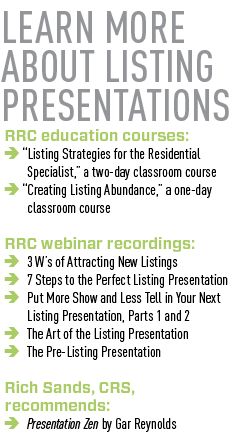Several CRS Designees share their tips for creating winning listing presentations
By Regina Ludes
When Wally Melte, CRS, began his real estate career, a formal listing presentation was not in his marketing arsenal. He eventually changed his tune. “I realized that if I wanted to compete in my market, I had to have a listing presentation,” says Melte, a salesperson with Platinum Realty in Overland Park, Kansas.
While Melte tweaks the presentation occasionally, it remains comparatively simple by today’s standards—a binder containing local market data and a letter outlining the sales process. When low inventory began having a detrimental effect on home sales, Melte realized he needed to address this issue with clients. So he altered his presentation by discussing basic economic concepts, such as the law of supply and demand and the law of scarcity, which have prepared his clients for the possibility of multiple offers at close to or above the asking price. He also started offering prepaid home inspections.
Melte says these moves have been a game changer for his business. “I pay more for inspection services than other agents, but it has resulted in repeat business,” says Melte, who estimates that 95% of his presentations result in listings and referrals.
According to the 2018 REALTOR® State of the Listing Presentation by REALTORS® Property Resource®, a subsidiary of the National Association of REALTORS®, nearly half of agents surveyed said listing presentations result in a signed contract 76% to 100% of the time. To reach that goal, it may be necessary to dump outdated methods and embrace 21st century marketing strategies, technology tools and even basic talking points for more engaging and customized presentations. Today’s successful agents understand that a customized presentation that addresses the client’s concerns will ultimately earn their trust—and their listing.

Talk less, listen more
While declining listings could be a sure sign that your listing presentation is stale and ineffective, agents should be aware of other signs. “If you are reading your slides to clients rather than conversing with them, that’s a problem,” says Rich Sands, CRS, with Rich Sands Seminars in Aurora, Colorado, who teaches the Council’s one-day course Creating Listing Abundance. Constantly using “I” and “me” rather than “you” shows an agent’s focus on his accomplishments rather than the client’s goals. Sands says it’s helpful to review your presentation before every appointment to prevent these miscues and create a better client-focused presentation.
Early in his career, Brian Ladd, CRS, with The Ladd Group/Cascade Sotheby’s International in Bend, Oregon, often rushed through presentations without pausing to ask questions. He has since learned to slow down, talk less about himself and listen more carefully to clients’ responses to his questions. “By asking the right questions up front, I can find the client’s sore subjects and alter my presentation accordingly. It also saves me the trouble of talking about services that aren’t relevant to my client,” says Ladd.
There are other tactics agents can use to uncover a client’s motivations, such as the worksheets that Pam Gebhardt, CRS, RE/MAX Around Atlanta in Atlanta, includes in her prelisting package. For example, one called “The Most Important Things My REALTOR® Needs to Know” asks about the client’s timeline for selling the home and the bottom-line offer they’re willing to accept. Then she discusses the responses with the client during the meeting. “By the end of the appointment, I have a clear idea how to approach the sale of their home. If I know they want a quick sale, for example, then I know I need to have an aggressive marketing plan,” Gebhardt says.
Customize your presentation
If you want to bring your presentation to the next level, customization is essential, says Sands. Customization involves two things:
- The methods of presentation delivery that work best with individual clients.
- The market data that is unique for their neighborhood and property type.
Gebhardt uses both print and digital tools for her listing presentations, but she customizes how they are used, depending on the seller. For a young, tech-savvy client, she uses her laptop to show housing data and sample virtual tours, while for older clients she keeps to a verbal conversation. The type of property also dictates which approach Gebhardt uses. “In my market, I have to customize each presentation because I can be selling a million-dollar house for one client and a $200,000 condo for someone else. They have to be marketed differently,” she says.
Tout your unique capabilities
Agents can use the listing meeting to describe what they do best, whether that is technology expertise, innovative marketing strategies or top-notch client service. Avoid bragging about professional accomplishments, however. Instead, frame your capabilities in ways that demonstrate how clients will benefit from your expertise. Melte shows his dedication to client service by offering prepaid inspections and staging services.
Gebhardt emphasizes her marketing expertise and the advanced training and networking she receives with her CRS Designation. As she shows clients the CRS brochure, she explains how the designation puts her in a stronger position to assist them. “I tell clients that I’m part of a network of professionals who share marketing tips and property information, which can help me sell their home faster.”
Spice things up digitally

For a serious shake-up or to bring your presentation into the 21st century, consider adding video or other digital elements. Ladd added home video tours to his business eight years ago, and he shows samples of them in his listing presentation. In each home video, Ladd does a personal walk-through of a seller’s house, both inside and out, and he hires a videographer with professional editing capabilities.
“The result is a higher-quality product than other virtual tour companies provide,” says Ladd.
Remember to thank the client afterward, whether with a handwritten note, a floral arrangement or something more impactful. Ladd sends short video messages to clients via text message, which he records in the driveway of the client’s home when leaving after the listing appointment. He avoids asking for clients’ business outright. Instead, he invites them to contact him with questions. He uploads the video to the platform BombBomb, which sends the message to the client’s cell phone that evening or the following day. “Rather than a lengthy conversation, the video is a personalized message that encourages clients to give me feedback right away,” Ladd says.
While there are many tools available to make a listing presentation more robust and engaging, agents who customize their presentation with the client’s needs in mind are sure to win the client’s trust—and their business.
Meet your Designation Maintenance requirements today! Read this article and “Home Prep with Buyer Appeal”, take a 10-question quiz and earn 2 credits. Go to CRS.com/trs-quiz to get started.








